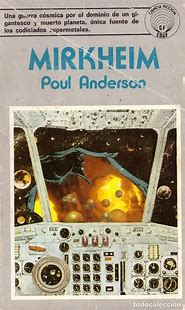Mirkheim, I.
Coya Falkayn tells her husband, David, about her earlier life:
"'I'd hear about the latest adventure of the fabulous Muddlin' Through team and go icy at the thought of what might have happened to you.'" (p. 33)
Thus, Coya helps consecutive readers to relive an earlier part of the series, more specifically two instalments in the previous volume of The Technic Civilization Saga. In "The Trouble Twisters," the team was on the planet, Ikrananka. In "Day of Burning," they were on Merseia. Retroactive continuity: although we did not know it then, we do know now that Coya Conyon followed those adventures just as we did. We also understand that there were many more such adventures between "Day of Burning" and the climactic events of Satan's World. "Lodestar" has already informed us of Coya's response to those particular events:

9 comments:
Kaor, Paul!
It also seems reasonable that some of Old Nick's competitors were inspired to send out their own trader teams. But we never see anything about them. Pity!
Ad astra! Sean
Note that even in an "age of adventure and discovery", most people just hear about it or hear/read stories about it. Conya's story about hearing of her grandfather's and David Falkyn' exploits as a teenager brings this out.
Kit Carson, one of the great American frontier scouts of the 19th century, once found a cheap pulp story supposedly about -his- adventures on the body of a woman killed by the Apache.
He was asked if there was anything true in it. He replied: "Some, but just by accident."
Before he died at the Alamo, Davy Crockett saw (and was hugely amused by) a play about himself as a frontier hero, while in Washington serving as a Congresscritter.
In fact, afterwards he was sometimes seen in a 'frontier costume' based on the one the actor playing him wore.
I think I've mentioned that when Cortez and his conquistadores came over the mountain ridge and saw the Valley of Mexico spread out below them, with the great cities and temples and pyramids, they reportedly turned to each other and said:
"This is like something out of 'Amadis of Gaul'"
Which was a very popular heroic fantasy adventure story of the time, full of noble knights and evil sorcerors and monsters and so forth. The Conan equivalent of the 16th century.
Life and art, art and life, they never stop shaping each other.
(And one of Robert E. Howard's famous Conan stories is taken almost word for word from an account of the death of Pizarro in a Spanish faction-fight in Peru, with Conan standing in for the Spaniard. And surviving, which Pizarro didn't, though the tough old buzzard took a good many with him.)
...and how many of you have read
"Despoilers of the Golden Empire" by David Gordon
1st published in Analog March 1959
I read it in a collection "Analog's Lighter Side"
The context in which I mention it should give you a hint about the ending of the story.
Kaor, Mr. Stirling!
Amusing, what Kit Carson's said, "Some, but just by accident"!
I even sometimes wonder if AMADIS OF GAUL would be worth reading, if I ever find a translation of the book.
Yes, the accounts I've read made it plain Pizarro was very hard for his enemies to kill. I also read, as he was dying, of Pizarro tracing a Cross with his blood and kissing it as he died.
Ad astra! Sean
Rodríguez de Montalvo's fiction left several names on the map, as well. ;)
Kaor, Dave!
I admit not being familiar with de Montalvo.
Ad astra! Sean
"California", IIRC.
Yup, checked, and it was de Montalvo's writings which used a fantasy realm, an "island east of Asia", named California.
Surprisingly similar to 20th-century pulp fantasy, in many ways!
Kaor, Mr. Stirling!
And some of our science fiction, pulp or not, may inspire future explorers and conquistadors in space!
As already seems to have happened with Elon Musk, a fan of Heinlein.
Ad astra! Sean
Post a Comment